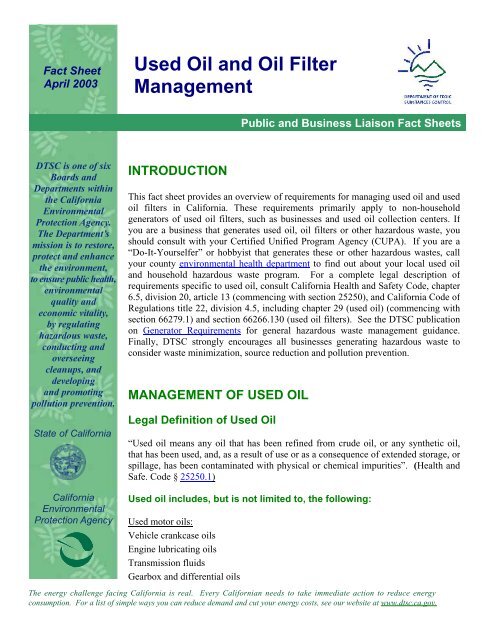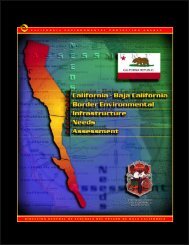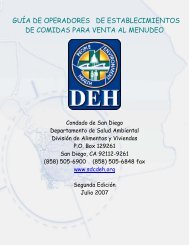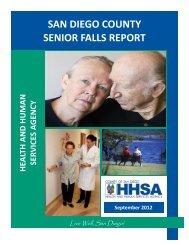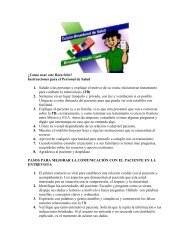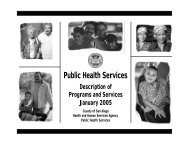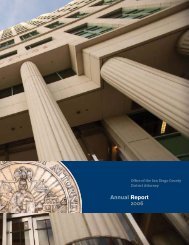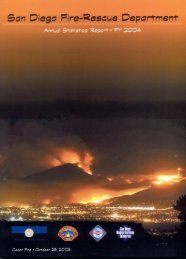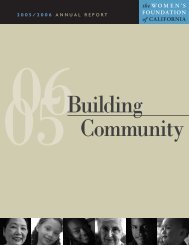Fact Sheet: Used Oil and Oil Filter Management - San Diego Health ...
Fact Sheet: Used Oil and Oil Filter Management - San Diego Health ...
Fact Sheet: Used Oil and Oil Filter Management - San Diego Health ...
- No tags were found...
Create successful ePaper yourself
Turn your PDF publications into a flip-book with our unique Google optimized e-Paper software.
<strong>Fact</strong> <strong>Sheet</strong>April 2003<strong>Used</strong> <strong>Oil</strong> <strong>and</strong> <strong>Oil</strong> <strong>Filter</strong><strong>Management</strong>Public <strong>and</strong> Business Liaison <strong>Fact</strong> <strong>Sheet</strong>sDTSC is one of sixBoards <strong>and</strong>Departments withinthe CaliforniaEnvironmentalProtection Agency.The Department’smission is to restore,protect <strong>and</strong> enhancethe environment,to ensure public health,environmentalquality <strong>and</strong>economic vitality,by regulatinghazardous waste,conducting <strong>and</strong>overseeingcleanups, <strong>and</strong>developing<strong>and</strong> promotingpollution prevention.State of CaliforniaINTRODUCTIONThis fact sheet provides an overview of requirements for managing used oil <strong>and</strong> usedoil filters in California. These requirements primarily apply to non-householdgenerators of used oil filters, such as businesses <strong>and</strong> used oil collection centers. Ifyou are a business that generates used oil, oil filters or other hazardous waste, youshould consult with your Certified Unified Program Agency (CUPA). If you are a“Do-It-Yourselfer” or hobbyist that generates these or other hazardous wastes, callyour county environmental health department to find out about your local used oil<strong>and</strong> household hazardous waste program. For a complete legal description ofrequirements specific to used oil, consult California <strong>Health</strong> <strong>and</strong> Safety Code, chapter6.5, division 20, article 13 (commencing with section 25250), <strong>and</strong> California Code ofRegulations title 22, division 4.5, including chapter 29 (used oil) (commencing withsection 66279.1) <strong>and</strong> section 66266.130 (used oil filters). See the DTSC publicationon Generator Requirements for general hazardous waste management guidance.Finally, DTSC strongly encourages all businesses generating hazardous waste toconsider waste minimization, source reduction <strong>and</strong> pollution prevention.MANAGEMENT OF USED OILLegal Definition of <strong>Used</strong> <strong>Oil</strong>“<strong>Used</strong> oil means any oil that has been refined from crude oil, or any synthetic oil,that has been used, <strong>and</strong>, as a result of use or as a consequence of extended storage, orspillage, has been contaminated with physical or chemical impurities”. (<strong>Health</strong> <strong>and</strong>Safe. Code § 25250.1)CaliforniaEnvironmentalProtection Agency<strong>Used</strong> oil includes, but is not limited to, the following:<strong>Used</strong> motor oils:Vehicle crankcase oilsEngine lubricating oilsTransmission fluidsGearbox <strong>and</strong> differential oilsThe energy challenge facing California is real. Every Californian needs to take immediate action to reduce energyconsumption. For a list of simple ways you can reduce dem<strong>and</strong> <strong>and</strong> cut your energy costs, see our website at www.dtsc.ca.gov.
<strong>Used</strong> industrial oils:Hydraulic oilsCompressor oilsTurbine oilsBearing oilsGear oilsTransformer (dielectric) oilsRefrigeration oilsMetalworking oilsRailroad oils<strong>Used</strong> oil does NOT include:AntifreezeBrake fluidOther automotive wastesFuels (gasoline, diesel, kerosene, etc.)GreaseSolventsSubstances which are not oils<strong>Oil</strong>s with a flashpoint below 100°F<strong>Oil</strong>s containing more than 1,000 parts permillion (ppm) total halogens unless therebuttable presumption is rebutted<strong>Oil</strong>s mixed with hazardous wasteWastewater containing small amounts ofused oil<strong>Oil</strong>s containing 5 ppm polychlorinatedbiphenyls (PCBs) or greater<strong>Oil</strong>y wastes that are not used oil<strong>Oil</strong>y wastewaters that are not used oilTank bottoms<strong>Used</strong> oil processing bottoms<strong>Used</strong> oil re-refining distillation bottomsCooking oils (edible)Note: Non-petroleum derived edible oils thatexhibit hazardous characteristics arehazardous wastes, but are not technicallyregulated as “used oil”.Managing <strong>Used</strong> <strong>Oil</strong><strong>Health</strong> <strong>and</strong> Safety Code section 25250.4requires used oil generators to manage usedoil as a hazardous waste in California unlessit qualifies for a recycling exclusion under<strong>Health</strong> <strong>and</strong> Safety Code section 25143.2 oris shown to meet the specifications forrecycled oil in <strong>Health</strong> <strong>and</strong> Safety Codesection 25250.1(b). In most instances, thismeans that the generator will contract with aregistered hazardous waste transporter tohave the used oil picked up within theappropriate accumulation period. Theaccumulation period is 90 days forgenerators of 2200 lbs. of hazardous wasteper month or more (large quantitygenerators) or 180 days for generators ofless than 2200 lbs. per month (small quantitygenerators). Small quantity generators mayaccumulate for up to 270 days if the oil issent to a used oil facility that is more than200 miles away. (Cal. Code Regs., title 22, §66262.34.) See the DTSC publication“Generator Requirements.” The transportermust take the oil to an authorized used oilstorage or treatment facility. <strong>Used</strong> oilstorage <strong>and</strong> treatment facilities can includepermitted transfer facilities, permittedstorage terminals, <strong>and</strong> used oil recyclingoperations that process the used oil intorecycled oil, fuel oil, or new lubricants.Mixing of hazardous waste, includinghousehold hazardous waste, with used oil isprohibited. Examples of hazardous wastesthat are prohibited are solvents, antifreeze<strong>and</strong> fuels. The law allows “minimal amountsof vehicle fuel” to be mixed with used oil,Page 2
like that which might occur during vehicleservice.<strong>Used</strong> <strong>Oil</strong> GeneratorRequirementsPersons or businesses generating used oil arerequired to meet all used oil generatorrequirements. <strong>Used</strong> oil collection centersmust meet the same requirements. (Cal CodeRegs., title 22, §§ 66279.20 <strong>and</strong> 66269.21.)Householders who change their own oil (doit-yourselfers)are not regulated as used oilgenerators. However, they must managetheir used oil appropriately by taking it to aused oil collection center <strong>and</strong> neverdisposing of it to l<strong>and</strong>, water, or stormdrains. Some communities have a curbsideused oil pickup program for residents; checkwith your local solid waste or environmentalhealth agency to find out. Householders areallowed to transport their own used oil to aused oil collection center or to a used oilrecycling facility if specified conditions aremet. These conditions are described in thisfact sheet under the section “Transporting<strong>Used</strong> <strong>Oil</strong>” <strong>and</strong> in <strong>Health</strong> <strong>and</strong> Safety Codesection 25250.11. Some communities have acurbside used oil pickup program forresidents; check with your local solid wasteor environmental health agency to see if itoffered in your area.A state EPA Identification Number isrequired for each site where used oil isaccumulated or stored, if the site does notalready have a federal or state EPA IDnumber. A generator who accumulates usedoil at two places in the same site needs onlyone EPA Identification Number. See theDuty Officer <strong>Fact</strong> sheet “EPA IdentificationNumbers”.Tanks <strong>and</strong> containers that are used for theaccumulation of used oil must be kept ingood condition. Tanks must be made ofnon-earthen, non-absorbing, rust-resistantmaterial such as steel or oil-resistant plastic,<strong>and</strong> have adequate structural support tocontain the used oil. There must be nosevere rusting, no apparent structural defectsor deterioration, <strong>and</strong> no leaking. Allcontainers must have tight-fitting lids thatare kept closed except when used oil isbeing added or removed. If a funnel is usedin the bunghole of a container, it must eitherbe removed when the container is not beingadded to (<strong>and</strong> the container closed), or beequipped with a valve or cover of some sortto prevent leakage if the drum should beturned over. Generators must regularlyinspect <strong>and</strong> maintain all storage tanks <strong>and</strong>containers, <strong>and</strong> repair or replace them asnecessary. Definitions of container <strong>and</strong> tankare given in California Code of Regulations,title 22, section 66260.10; the references togeneral tank <strong>and</strong> container managementrequirements are found in California Codeof Regulations, title 22, section 66262.34subsection (a)(1).Secondary containment is required forstorage tanks. This is a backup containmentsystem designed to prevent the release <strong>and</strong>migration of wastes or accumulated liquidsfrom a storage tank or a storage tank system.Examples of secondary containment systemsinclude an impervious bermed area or liner,a vault, or a double-walled tank.Labeling <strong>Used</strong> <strong>Oil</strong>Above-ground storage tanks <strong>and</strong> containersaccumulating used oil, <strong>and</strong> fill pipes used totransfer used oil into underground storagetanks must be labeled with the words“USED OIL”, “HAZARDOUS WASTE”,<strong>and</strong> the initial date of accumulation. Inaddition, containers must be labeled with thename <strong>and</strong> address of the generator. (Cal.Code Regs., title 22, § 66262.34 subsection (f))For shipping, containers must also be labeledas follows:Page 3
HAZARDOUS WASTE - State <strong>and</strong> FederalLaw Prohibit Improper Disposal.If found, contact the nearest police or publicsafety authority, the U.S. EnvironmentalProtection Agency or the CaliforniaDepartment of <strong>Health</strong> Services.• Generator’s name <strong>and</strong> address• Proper Department of Transportation(DOT) shipping name• Uniform Hazardous Waste Manifestnumber <strong>and</strong> the shipping identificationnumberThe Rebuttable Presumption(<strong>Health</strong> <strong>and</strong> Safe. Code, §25250.1, subdivision (a)(1)(B)(v) <strong>and</strong>Cal. Code of Regs., title 22, §66279.10)<strong>Used</strong> oil h<strong>and</strong>lers, including generators,used oil collection centers, transporters,transfer facilities <strong>and</strong> used oil recyclingfacilities) are required to determine whetherthe total halogen content of each used oilshipment exceeds 1,000 ppm. Spenthalogenated solvents, such as TCE <strong>and</strong> PCE,are federally regulated wastes. The lawpresumes that used oil containing more than1,000 ppm total halogens has been mixedwith halogenated hazardous waste <strong>and</strong>requires that it be managed as a federalResource Conservation <strong>and</strong> Recovery Act(RCRA) hazardous waste unless thegenerator can demonstrate that such mixinghas not occurred (i.e., unless thepresumption is rebutted). This is called the“rebuttable presumption.”If a generator, transporter or used oilcollection center chooses to rebut thepresumption, it must be done in accordancewith criteria specified in California Code ofRegulations, title 22 sections 66279.10,subsection(a)(1)(B) for generators66279.10, subsection (a)(3)(B) fortransporters, <strong>and</strong> 66279.10, subsection (a)(6)for used oil collection centers.<strong>Used</strong> oil transfer facilities <strong>and</strong> used oilrecycling facilities are required to test eachshipment of used oil for total halogensbefore accepting the shipment. SeeCalifornia Code of Regulations, title 22,section 66279.10 subsection (a)(4) & (a)(5).In order to rebut the presumption that theused oil shipment was mixed with RCRAhazardous waste, the used oil h<strong>and</strong>ler mustdemonstrate that the oil was not mixed withhalogenated hazardous waste. Where therebuttal is successful, the oil is regulated as“used oil” rather than RCRA hazardouswaste. The presumption is deemed rebuttedfor the following three types of used oilswhere specified conditions are met (Cal.Code Regs., title 22, § 66279.10,subdivision (b)):(1) metalworking oils or fluids containingchlorinated paraffins,(2) refrigeration oils contaminated withchlorofluorocarbons, <strong>and</strong>(3) used oil which is exclusively household“do-it-yourselfer” used oil or used oil from aconditionally exempt small quantitygenerator. (A conditionally exempt smallquantity generator generates no more than100 kilograms of RCRA hazardous waste ina month <strong>and</strong> does not accumulate more than1,000 kilograms of hazardous waste onsiteat any time. (40 C.F.R. § 261.5).Transporting <strong>Used</strong> <strong>Oil</strong>In general, California law requires that aregistered hazardous waste transportertransport used oil. However, householders<strong>and</strong> other generators of used oil maytransport up to 20 gallons of used oil per tripto an authorized used oil collection center ifthe oil is carried in containers that hold 5Page 4
gallons or less <strong>and</strong> specified conditions aremet. Generators of used oil may transportup to 55 gallons of oil in containers of notgreater than 55-gallon capacity if they getprior permission from the used oil collectioncenter. Authorized used oil collectioncenters include certified used oil collectioncenters (Public Resources Code section48622), recycle-only household hazardouswaste collection facilities, or collectionfacilities operating pursuant to <strong>Health</strong> <strong>and</strong>Safety Code section 25250.11. Mobilemaintenance operations (see below) mayalso transport up to 55 gallons of used oil inany one vehicle at any one time from an offsitelocation to a consolidation point.When transported by a registered hazardouswaste transporter, used oil shipments mustbe accompanied by either a st<strong>and</strong>ardhazardous waste manifest or a consolidatedhazardous waste manifest. (<strong>Health</strong> & Safe.Code, § 25160 & 25160.2) When using aconsolidated manifest, the driver mustprovide the generator (at the time of used oilpickup) with a legible copy of a receipt foreach quantity of used oil received. Thegenerator must maintain these receipts for 3years. Each receipt must contain thefollowing information:• Generator’s name, address, EPAIdentification Number, contact person <strong>and</strong>telephone number. Note: as of January 1,2002, the exemption from EPA numberrequirements for small generators of usedoil was rescinded. See the <strong>Fact</strong> <strong>Sheet</strong>“EPA Identification Number”.• Generator’s signature or signature ofgenerator’s representative• Date of shipment• State manifest number (pre-printed on themanifest)• Volume, waste code(s), waste type (under25160.2(c), <strong>and</strong> shipping description• Name, address <strong>and</strong> identification numberof the authorized facility that will receivethe used oil• The transporter’s name, address <strong>and</strong>identification number• The driver’s signatureThe statute also requires the generator toprovide a signed waste minimizationstatement. The statement certifies that thegenerator has established a wasteminimization program to reduce the volumeor quantity <strong>and</strong> toxicity of the waste as muchas is economically practicable. In the caseof used oil generated by routine vehicle orequipment service, the generator is notrequired to reduce the used oil generation.But for waste oils generated throughequipment leaks or processes that could bemade more efficient, the generator shouldhave a plan to reduce the generation of thewaste.Mobile Maintenance Operations(<strong>Health</strong> <strong>and</strong> Safe Code § 25250.12)Businesses that generate used oil in theperformance of routine maintenanceoperations at off-site locations are subject tospecial requirements. Such businessesinclude off-site heavy equipment operations(e.g., construction vehicle fleets) <strong>and</strong> mobileoil-changing businesses that provide oilchanges for personal <strong>and</strong> business vehiclesat the customer’s location. The followingrequirements apply:• The business owner/operator must have apoint of consolidation for the used oil• The point of consolidation must not be at aresidence or residential location• The business must have an EPA IDnumberPage 5
• The business or an employee of thebusiness must own the transport vehicle.• The business is not required to register asa hazardous waste transporter as long as ittransports no more than 55 gallons of usedoil from off-site location(s) to the point ofconsolidation at any one time.• The used oil is considered to be generatedat the point of consolidation when itarrives at the consolidation point.• The used oil must be h<strong>and</strong>led <strong>and</strong> stored atthe point of consolidation in accordancewith all applicable hazardous waste laws.• The consolidated used oil must betransported by a registered hazardouswaste transporter from the point ofconsolidation to a permitted used oilrecycling facility.Spent Absorbents <strong>and</strong> RagsAbsorbents used to soak up miscellaneousdrips <strong>and</strong> leaks of oil from machinery ordevices do not fall under the definition ofused oil must be managed like any otherwaste. The generator must characterize thewaste as hazardous or non-hazardous, <strong>and</strong>manage it according to the appropriateregulations. Absorbents that have been usedto soak up spills from used oil tanks <strong>and</strong>containers should be managed as hazardouswastes. Reusable fabrics, such as oily rags<strong>and</strong> coveralls, can be sent for commerciallaundering. (<strong>Health</strong> <strong>and</strong> Safe. Code, §25144.6.) Reusable absorbents being sentoff for recycling can be managed as allowedby California <strong>Health</strong> <strong>and</strong> Safety Codesection 25143.2.Many municipal waste programs prohibitthe disposal of oily waste to the municipaltrash even when the wastes pass thehazardous waste tests. You must check withyour local CUPA <strong>and</strong> solid waste programto see how to manage oily wastes in yourarea. Householders should collect their oilywastes for household hazardous wasteevents. If your business commonlygenerates spent oily absorbent, werecommend that you contact your localPollution Prevention Program to see if thereis a management method or product that canreduce your generation of waste. See theDTSC Pollution Prevention Webpage athttp://www.dtsc.ca.gov/.MiscellaneousIt is unlawful to dispose of used oil on l<strong>and</strong>,to sewers <strong>and</strong> other water systems, or toburn used oil as a fuel or by incineration,including in space heaters, boilers <strong>and</strong>similar devices. The use of used oil as adust suppressant (road oiling) or for insector weed control is also prohibited by law.(<strong>Health</strong> <strong>and</strong> Safe. Code, § 25250.5.)Generators of used oil who also operate usedoil collection centers, such as servicestations, should not mix the used oilgenerated in their business with the used oilfrom the collection center. The rebuttablepresumption is not rebuttable if used oilfrom householders or conditionally exemptsmall quantity generators has been mixedwith used oil from other sources.MANAGING USED OILFILTERS (Cal. Code Regs., title22, § 66266.130)Introduction<strong>Used</strong> oil filters may exhibit hazardouscharacteristics for lead, other heavy metals<strong>and</strong> petroleum-derived compounds. Thissection of the fact sheet outlines the specialregulations that DTSC adopted in 1991 toencourage recycling of used oil filters.Page 6
Unless they are proven to be non-hazardousby laboratory analysis, used oil filters notmanaged according to the used oil filterregulations must be managed as fullyregulated hazardous waste. Impropermanagement of used oil filters can result insignificant fines <strong>and</strong> penalties. Do notdispose of used oil filters in trashcans <strong>and</strong> atnon-hazardous waste l<strong>and</strong>fills.Fuel filters, including fuel dispenser <strong>and</strong>diesel fuel filters, usually exhibit hazardouswaste characteristics, <strong>and</strong> may not bemanaged in the same manner as used oilfilters. They may not be placed into yourused oil filter drum unless you are managingyour used oil filters as hazardous wastes. Iffuel dispenser filters are being transportedunder consolidated manifesting, thetransporter may place different generators'fuel filters into one container for shipment,but may not mix them with oil filters beingmanaged according to the used oil filterregulations.Summary of Generator <strong>Management</strong>Requirements for <strong>Used</strong> <strong>Oil</strong> <strong>Filter</strong>s:• Drain <strong>and</strong> collect the free-flowing oil fromthe filters <strong>and</strong> manage the collected oilunder the requirements for used oil.• Properly contain, label <strong>and</strong> store the usedoil filters.• Store them within the allowed time limits.• Transport them under a bill of lading to anapproved destination for purposes of metalreclamation.• Keep a copy of the bill of lading for threeyears.Detailed <strong>Management</strong>RequirementsDraining<strong>Used</strong> oil filters must be drained of all freeflowingliquid. “Free-flowing” means acontinuous stream of used oil from the filterwhen it is overturned. <strong>Used</strong> oil that flowsdrop-by-drop is not considered to be freeflowing.If the filter is equipped with aflapper valve or other device that blocks thedrainage, that device must be opened toallow the used oil to leave freely.Generators may puncture, crush, open,further drain or otherwise h<strong>and</strong>le drained oilfilters to prepare them for recycling. Thistreatment does not require a permit, but thegenerator must properly manage all used oil<strong>and</strong> other residues that result.ContainersAfter the filters have been drained,generators <strong>and</strong> agencies that accept used oilfilters from householders must place them ina container that can capture all of the usedoil that drains from the filters. Thecontainers of used filters must be:• Labeled as “Drained <strong>Used</strong> <strong>Oil</strong> <strong>Filter</strong>s”• Clearly marked with the initial date ofaccumulation or receipt. The initial dateof accumulation is the date when the firstfilter is placed in the container, or the datewhen a full or partially full container offilters is received at a second location• Rainproof, non-leaking, closed containers• Sealed during transfer so that used oil willnot spill out when they are laid or fall ontheir sides.Page 7
StorageGenerators may store up to one ton of usedoil filters for a period of up to one year, <strong>and</strong>storage of one ton or more of used oil filtersis limited to 180 days, unless the storagefacility has a hazardous waste permitauthorizing longer storage.Allowed DestinationsThe only allowed destinations for used oilfilters are:• To a smelter or scrap metal processor forrecycling• To a municipal solid waste incinerator forenergy recovery if the residual casingsthen go to a smelter or scrap metalprocessor for recycling• To a storage or consolidation facility thatthen transfers the filters to a smelter, scrapmetal processor or municipal solid wasteincinerator as described above.• To an authorized hazardous waste facility.Transportation• Only transport properly-drained filters• Prevent any spillage of used oil by sealingthe containers tightly before transportation• Secure the containers in the transportvehicle to prevent movement or tippingduring transportation.• Use a bill of lading with each shipment ofused oil filters, <strong>and</strong> include the followinginformation on the bill of lading:• Generator’s name, address, <strong>and</strong>telephone number• Transporter’s name, address, <strong>and</strong>telephone number• Name, address <strong>and</strong> telephone number ofthe receiving facility.• Quantity <strong>and</strong> size of the containers in theshipment• Date of transportation• A copy of each bill of lading must bemaintained by the transporter, generator<strong>and</strong> receiving facility for 3 years.USEFUL CONTACTINFORMATIONDTSC Public <strong>and</strong> BusinessLiaisons (Duty Officers)If you cannot find the answer to yourquestion in this fact sheet, contact the DTSCPublic <strong>and</strong> Business Liaisons (DutyOfficers). You can call them at 800-728-6942, or contact them through theDepartment of Toxic Substances Controlwebsite — http://www.dtsc.ca.gov — followthe “Toxic Questions?” <strong>and</strong> “Contact a LivePerson!” links to the page listing each of theDuty Officers’ email addresses.DTSC Public <strong>and</strong> Business Liaisons’ role isto provide informal guidance regardingmanagement of hazardous waste for theconvenience of the public. Such advice isnot binding upon DTSC, nor does it have theforce of law. If you would like a formalopinion on a matter by DTSC, please contactthe responsible program office directly.You should also refer to the statutes <strong>and</strong>regulations, DTSC Policies <strong>and</strong> Procedures,<strong>and</strong> other formal documents.We also encourage you to complete aCal/EPA Customer Satisfaction surveyhttp://www.calepa.ca.gov/about/custsvc.htmso that we may improve our Public <strong>and</strong>Business Liaison Program.Page 8
Other Useful NumbersFor specific locations of authorized usedoil collection centers in your area:Cal/EPA Recycling Hotline:1-(800) CLEAN-UP or 1-(800) 253-2687 orhttp://www.earth911.org/For additional information on EPA IDNumbers, see the online fact sheets“EPA Identification Numbers” <strong>and</strong>“Hazardous Waste Generator Requirements”DTSC Generator Information ServicesSection, phone number (916) 255-1136 or(800) 618- 6942 (California only), can issueCalifornia EPA ID numbers.To report illegal disposal or managementof used oil or used oil filters, contact:Your local Certified Unified ProgramAgency or DTSC Waste-Alert Hotline at(800) 698-6942 or911 - Only if you see a crime (such asdisposal to a storm drain) in progress.See the online list of local governmentcontacts:http://www.dtsc.ca.gov/ContactDtsc/contacts2.htmlPage 9


